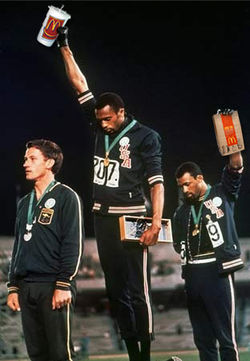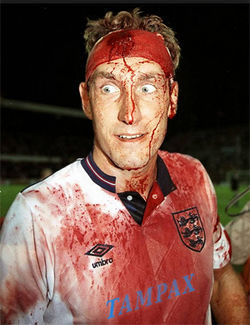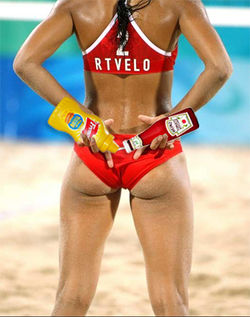Great Moments of Sports Advertising
“When seagulls follow the trawler, it is because they think sardines will be thrown into the sea...”
– Eric Cantona on Ayam Brand Sardines
Who can forget where they were the first time they watched an advert for Doritos during the Superbowl? The buzz and excitement as you await each ad break? "Mean" Joe Greene swapping a sweaty rag for an overly-caffeinated sugary drink? The importance of sports advertising in our lives is so monumental and so ingrained within the fabric of society that we are often guilty of taking it for granted.
Childhood Obesity[edit | edit source]
“I spent 90 percent of my money on women and drink. The rest I wasted!”
– George Best: Ticketmaster Advert
The 1960s were a period of great change and upheaval within society and the advertisement industry alike. Individual endorsement by celebrities, including sporting gentlemen, was all the rage from the late Victorian Age onwards. W. G. Grace was an ironic spokesperson for an early version of the Gillette Razor.
As the 1960's got into full swing, advertising began to diversify, as television became a familiar site within the home, and sporting events began to become a regular event. Billboards, which would be in shot as the camera followed the action allowed for a more subtle form of advertising. It also led to product placement, with the players necking a can of lager or smoking brands of cigarettes during the half time break. As the decade wore on the actual sport almost became a distraction for a number of athletes, with many struggling to differentiate between the need to maintain their sporting activities and their corporate prostitution.
This more subliminal advertising can be seen within Kenneth Wolstenholme's famous commentary towards the end of the 1966 World Cup Final between hosts England and Germany. "And here comes Hurst! He's got.....some people are on the pitch! They think it's all over! It IS now! And that's when I like to enjoy the smooth, satisfying filtered taste of Winston Cigarettes..."
Sugar Industry Lobbying[edit | edit source]
“Lennox Lewis, I'm coming for you man. My style is impetuous. My defense is impregnable, and I'm just ferocious. I want your heart. I want to eat his children. Praise be to Allah!”
– Mike Tyson: Spokesman for Nibbler's Snacks
By the early 1980s club and shirt sponsorship was becoming the norm, whilst stadium naming rights had begun to lead to the renaming of iconic sporting venues, such as Wrigley "Wrigleys" Field, Goodison "Every Little Helps" Park, Lord's "Home of the Big Mac" Cricket Ground, and numerous others.
Additionally, sports clothing began to make its way into everyday use, with many overweight, workshy couch potatoes seeking to emulate the look of their favourite players. Brands such as Nike, Adidas and those cheap ones that nobody wears until they don't have enough money for the real versions began to be viewed just as much as streetwear as sportswear. Sweaty looking Greek and Italian men squooze their ample frames into tracksuits and trainers. During this period branded sportswear became the de facto urban clothing, with the standard baggy track pants, tshirt, trainers and the ubiquitous reversed baseball cap assimilated into nations that wouldn't know a shortstop from a hole in the ground.
A small minority point out that many are failing to see the irony in watching overpaid "athletes" running round in overpriced shoes made in a foreign sweatshop (under the prefix of supporting your local or national team) by a national company that moved its headquarters to another country to avoid paying tax and shut its local factories because its easier to pay kids in Cambodia and Pakistan to work 18 hour shifts seven days a week rather than pay you, Schmuck!
Links to Cancer[edit | edit source]
By the time we reached the era of the internet and 24 hour broadcasting the bombardment of advertising has become a global phenomena, with the wealthiest corporate entities spending billions to show their product in 15 second slots, as annoying pop ups on your favourite porn sites, as well as splashing them across every form of media known to man, just in case they missed anyone. And because people are shallow-minded sheep, these effective marketing campaigns bring in riches at levels above the annual gross domestic product of all but the richest seven nations in the world.
Following thirty-plus years of neo-liberal propaganda the line between corporate advertising within sports, the media and politics has blurred to microscopic levels. Multi-National Banking Institutes, Insurance and Credit Card companies have long since pushed aside "Eat at Joes" local businesses in the clamour for brand dominance.
Athletes, once dedicated and committed amateurs who would work in factories and travel on the same buses to matches as the fans, are now paid tens, even hundreds of millions per year. They live cosseted lives of privilege, cut off from the realities of the world, dating models and singers and pushing their own range of clothing and perfume onto the baying public. Bread and circuses, anyone?
Few now can recall an era before Women's Beach Volleyball became an Olympic Sport or the four yearly spike in vaseline and babywipe sales that accompany the television coverage as shares skyrocket on the Stock Exchange. Over the years sports advertising has given us so many special moments that sometimes we fail to credit it with the value it offers to our lives, from the range of overpriced Italian clothing made in Taiwan that we wear, the top of the range computers, TVs and entertainment systems that fill the gaping void that community and family once held, the great banks and moneylenders of the world that have allowed us to accrue the debt of a small island, so that we are able to maintain our desire for all these items.
Sporting Advertisements, we salute you!


